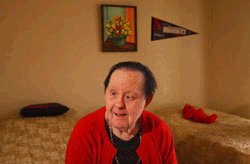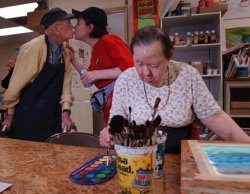Our parent support group has scheduled monthly meetings the first Friday of each month at St. Paul's Lutheran Church, 106 N. Border St., Troy, IL 62294 from 6:30 p.m. - 9:00 p.m. From 55/70, take the Troy/162 exit (#18). Go east on 162 towards Troy. Go 1.3 miles. Turn left on West Clay Street. Parking lot will be on your left.
The Southern Illinois University at Edwardsville, Department of Kinesiology & Health Education, presents a Physical Activity Lab, Fall 2004, Wednesdays, 5:15 - 7:00 p.m. Oct. 13, 20, 27; Nov. 3, 10; Dec. 1, 8.
This is a free Inclusive Motor Development Lab for children ages 3 - 18 (with and without disabilities).
Instructors are Kinesiology & Special Education students.
The purpose of the lab is two-fold;
- To provide hands-on experience (to future special education & kinesiology teachers) with children of all abilities in a general physical education setting.
- To provide an opportunity for children with and without disabilities to interact in a positive environment with an emphasis on physical fitness, and acquisition of locomotor and object-control skills.
For more information contact:
Tammy L. Burt, Ph.D.
E-mail: tburt@siue.edu
Department of Kinesiology & Health Education
Southern Illinois University Edwardsville
Edwardsville, IL 62025
Phone: (618) 650-2876
Fax: (618) 650-3719
Consumer Stipend Grant Renewed. The Arc of Illinois administers the Consumer Involvement Program and distributes $100,000 each year for consumer stipend funds to enable people with developmental disabilities and their family members to attend conferences of their choice that are directly related to developmental disability issues.
|
 |
The Consumer Involvement Program is highly flexible, and we hope you will make people aware of this important opportunity. Here are some basics of the Program:
Who Can Apply?
- Illinois resident.
- A person with a developmental disability.
- A parent of a person with a developmental disability.
- An immediate family member of a person with a developmental disability.
- A guardian/foster parent of a person with a developmental disability.
What Can I Apply For?
- Conference must be directly related to developmental disabilities.
- In Illinois or out-of-state.
What Can I Use These Funds For?
- Conference Registration.
- Child Care.
- Respite Care.
- Meals.
- Personal Attendant.
- Hotel.
- Transportation.
- Other expenses directly related to attending the conference.
How Much Can I Apply For?
- $300 per person per year.
- $500 per family per year.
How Do I Apply?
- The application form must be completed and returned to The Arc of Illinois with a copy of the conference brochure and a completed registration form 30 days prior to the date of the conference.
- Application forms can be downloaded from www.TheArcofIL.org
- Application forms are available by calling The Arc at (708) 206-1930.
|
|
|
Oral Motor Myths and Speech Therapy Options for Children with Down Syndrome Beginning at Birth. Down Syndrome Association of Greater St. Louis Educational Series Meeting. July 12, 2004.
I will be discussing common errors in assumptions about how a child with Down syndrome will talk and function in regard to oral-motor function. The simple approaches can be performed by trained caregivers in the context of daily living and result in good foundations for future speech production by the child. The information presented will be based on the research and publications by Sara Rosenfeld-Johnson, Speech Pathologist.
My name is Wendi Thomasson. I have an undergraduate degree from Northeast Missouri State University (Truman University) and a Master's degree from St. Louis University, both in the area of Communication Disorders. I have been a practicing speech pathologist for 11 years. My focus has been on the birth-to-3 years age population for the past 4 years and emphasis on oral-motor treatment for the past 2 years. The bulk of what I do now involves the treatment of children with a diagnosis of Down syndrome. On a personal note, I am married with 3 boys ages 6, 5 and 3 and reside in the North St. Louis County area.
This approach is based on principles utilized by Occupational and Physical Therapists. That is, you need to improve muscle movement before speech can improve. This approach can be utilized with any age client with any type of difficulty.
It teaches:
- Awareness placement
- Strength/muscle memory production
Myths of Down Syndrome
- Open mouth posture
- Interdental tongue posture
- Large tongue
- Upper respiratory problems
- Mouth breathing
- High, narrow palatal vault
- Conductive hearing loss
Things we do to address these beginning at birth are:
- choice of bottles/nipples and method of feeding
- spoon feeding
- cup drinking
- straw drinking (begin at 8 months)
- solids
Key to program: Must have stability in jaw for mobility in lips and tongue!
This program is a supplement to language activities not a replacement.
Speech = the production of sounds
Language = the meaning of words and communication
 |
| Straw Hierarchy |
Tools & Exercises
This is an overview of some of the commonly prescribed exercises. There is a whole hierarchy to each set. Each child will be different. Rules:
- The child is always to be seated with hips, knees and ankles at 90 degrees, with feet on firm surface, with hands at mid-line or in their lap.
- These are tools therefore only adults hold the tools. The child should not play with or touch any of the therapy tools.
- Bubble-Blowing-Target: controlled elongated airflow as well as the connection that oral air can be used to make something happen.
- Straw-drinking-Target: lip-rounding and protruding, tongue retraction, strengthening of facial muscles, jaw stability. No biting!
- Horns-Target: tongue retraction, jaw grading, lip rounding and protruding, abdominal support for good airflow. No biting!
- Jaw Exercises-Target: jaw grading, tongue retraction. See list of foods that encourage chewing.
Infants: We obviously can't do a lot of formal exercises with infants. Through individualized methods of bottle-feeding, spoon feeding, and eventually cup drinking, many of the myths I listed in the beginning are eliminated if not at least minimized. Ultimately, this has a positive impact on future speech clarity.
 |
| Horn Hierarchy |
Resources:
Talk Tools, Innovative Therapists International 1 (888) 529-2879 or www.talktools.net.
Oral-Motor Exercises for Speech Clarity by Sara Rosenfeld-Johnson
Wendi Thomasson. Thomasson & Associates 21 Jamestown Farm Drive Florissant, MO 63034. (314) 954-6559 wltspeech@sbcglobal.net.
Foods That Encourage Chewing
Beginning Stage:
- Cubes of hard cheese such as cheddar, Monterey jack, American
- Cubes of white meat chicken roll, turkey roll
- Partially cooked carrots, potatoes, green beans-cubed or cut in lengths for biting
- Grilled cheese sandwiches—cubes or strips
- French toast—cubes or strips
- Firm omelets—cubes or strips
- Waffles—cubes or strips
- Crunchy cereals— Kix, Cheerios
- Fresh bananas-cubes, canned fruit (pears, peaches)—cubed
Second Stage:
- Cubes of harder foods-bologna, turkey hotdogs, poached chicken
- Cold meatloaf cubed
- Firm, solid meatballs
- French fries
- Chicken nuggets—cubes or strips
- Ravioli—cubed
- Ziti noodles cooked al dente
- Toast—cubes or strips
- Pepperidge Farms (Goldfish)
- Fresh fruits-pears, peaches—cubes or strips
- Firmly cooked vegetables—cubes or strips
Regional Events
October 11, 2004. 7:00 p.m. Down Syndrome Association of Greater St. Louis Educational Series Meetings: Down Syndrome and Early Literacy. Ages 0 - 3. Victor and Emmanuel Bishop will present methods and tips, based on the relative visual strengths in Down syndrome, to provide toddlers with Down syndrome an opportunity to excel with sight-reading during the early intervention years.
Please RSVP via e-mail to Anne Wadell, toaster03@charter.net or by calling the DSAGSL office at (314) 961-2504.
October 16. 2004 Walk 'n' Roll Buddy Walk. Registration will begin at 10:00 a.m. in the center of the main campus of Beverly Farm, 6301 Humbert Road, Godfrey, IL 62035. Look for the big tent. The walk will begin at 11:00 a.m. and end at center campus. Walkers will proceed around the one mile roadway on the 220 acre campus. After the walk, lunch will be served at the tent, prizes given and entertainment enjoyed. Beverly Farm Foundation is a private, not-for-profit, residential and nationally accredited training center and certified by the State of Illinois to serve adults with developmental disabilities and is hosting the Buddy Walk. The dollars raised will support Beverly Farm's Community Riding Program and the National Down Syndrome Society. Cost to participate: $10 per person; $25 per 4-person family.
The Buddy Walk was developed by the National Down Syndrome Society in 1995 to promote acceptance and awareness of people with Down syndrome. People with Down syndrome are encouraged to invite "Buddies" —everyone from friends and family to teachers, legislators and celebrities—to join them in the Buddy Walk. All Buddy Walk donations are 100% tax deductible.
For more information call Candy Mark at: (618) 466-0367 ext. 628 or cmark@beverlyfarm.org.
STARNet Region IV
December 3, 2004. Registration & Continental Breakfast: 8:30 am - Workshop: 9:00 am - 3:00 pm. A Transdisciplinary Approach to Evaluation and Treatment in Feeding Disorders in Young Children. Ramada Inn, 6900 North Illinois, Rte 159 & I-64, Fairview Heights, IL (For directions only: (618) 632-4747).
This feeding workshop will discuss the cause of feeding disorders and how to evaluate the severity of the disorder. In addition, therapy techniques to decrease oral defensiveness, increase intake, move from tube-feedings to oral feedings and many other problems related to feeding will be addressed. Parent involvement and carry-over into the home is the most important factor for successful feeding outcomes. Ways to work with parents and caregivers to prescribe a home feeding plan will be discussed.
About the Presenter: Beth McEvoy, M.A., CCC-SLP a Pediatric Speech-Language Pathologist for thirteen years, currently serves as the Coordinator of Clinical Services and an instructor at Southern Illinois University Edwardsville, but will be leaving to expand her private practice in Edwardsville, Illinois. Beth has lectured extensively on speech and language disorders, feeding and swallowing issues, developmental verbal apraxia and medically fragile children, birth to five years of age.
For further information contact Kathy Hollowich, 397-8930, E-mail: khollowich@stclair.k12.il.us.
Down Syndrome Articles
Behavior Paves the Road to Success by Laura Watts, M. Ed., Program Director, E-mail: LauraW@hope-haven.org, At The Center, A publication of The Down Syndrome Center, March 2004, p. 1.
Acceptance of Down syndrome has come far and the journey has been long. For decades life-saving medical interventions were withheld because the "quality of life" was considered poor. But as it was discovered that surgeries could repair major organic defects and proper nutrition could ensure a healthier life it was also discovered that the ''quality of life" could improve. And so the focus was turned to new-found information about the medical issues of this population. People with Down syndrome began to live longer. They demonstrated desires for recognition and the need to be productive. And suddenly they needed something to do with their lives.
And so education became the new buzz word. Families wanted their children to learn so they could get jobs and become independent. The focus switched from medical research to specialized teaching methods. Reading and math became goals of Individualized Educational Plans and academics the new way to measure success. But no where in this grand plan was addressed the issue of how these individuals were going to face the challenge of being surrounded by peers who were faster, more articulate and even bigger than they were. No longer was it acceptable to just smile and be loved. Suddenly these sweet, angelic children became challenged with "normal" expectations that were not always of their choosing. And so, "normal" reactions occurred. Defiance, uncooperativeness and even signs of stress began to surface. Behavior, not health or intelligence, became the identifying characteristic of this population.
Because of these advances in medical care and educational opportunities, our children are now employed in ways not experienced in the past. Children and teens with Down syndrome have shown themselves to be bright, capable youngsters who are clearly able to understand the effects of their behaviors — appropriate or not — on the people around them. Using this new-found capability can now become their primary goal and we as parents are suddenly faced with the fact that we may no longer be in control.
Although every child is different and there is no pat answer to this new dilemma, our experience here at the Center indicates that our children can learn to behave and become productive members of our society. Firm, consistent discipline plans can be implemented with much success. Programs such as S.O.S., 1-2-3 Magic and John Rosemond have been used by many of our families, but the choice of plan ultimately depends on your family's individual needs and abilities. Behavior specialists are also available through schools for in-class issues and private behavior therapists can work with families to ensure that appropriate behavior is carried through at home.
Additional underlying causes - such as ADHD, autism, learning disabilities and sensory deficits should also be considered. If you and the teacher have exhausted all behavior management options with negligible results, it may be time to consult a team of professionals. Behavioral pediatricians, sensory integrationists and psychologists can work together to identify needs and strengths. Psychological/educational testing can be administered which may reveal deficits or specific learning disabilities.
As parents we have dreams for our child's future. We have places we want her to see, people we want her to know and things we want her to do. And now we know that these children have dreams for themselves. Working on behavior at the earliest age possible will keep those dreams from becoming narrowed down to choices made for us by the people who can or cannot handle our child.
The journey towards acceptance of our children has come far — and conquering this new bend in the road will bring our children even closer to the final destination.
The art of survival by Cynthia Hubert, Bee Staff Writer, (916) 321-1082 or chubert@sacbee.com, May 30, 2004. Copyright © The Sacramento Bee.
Life is already an accomplishment for Irene Pinole, born with Down syndrome in 1928. But through her painting she has achieved much more.
Irene Millie Pinole was born on a January day in 1928, in a hospital in the heart of California's wine country.
Statistically speaking, she should have been dead by the age of 10.
 |
| Irene Pinole, 76, lives at a group home in south Sacramento. Born during an era when people with Down syndrome were considered hopeless cases, she was institutionalized for decades. Photo: Sacramento Bee/Anne Chadwick Williams. |
But against the longest of odds for a child with Down syndrome in her era, Irene grew up and grew old. Now she is 76, ranking her among the oldest Down survivors on record.
But Irene is more than just a survivor.
At 4 feet 6 inches tall in her soft, sensible shoes, she stands as a mother figure to some, a surrogate daughter to others. And when she leans over her easel at the Short Center South art studio in Sacramento, ignoring the chaos around her as she paints broad, meticulous strokes on white paper, she is the grande dame.
"I do watercolors," Irene says, her words garbled by her disability and the fact that she refuses to wear her uncomfortable dentures. "You want to see?"
Like Irene herself, the painting is gentle and orderly, minimalist in the manner of Agnes Martin.
As the radio plays an instrumental version of "The Look of Love" for her and her fellow artists, Irene carefully dips her brush into her palette and adds a line of pale blue to her masterpiece.
She pauses.
"The ocean," she says. "Hawaii."
Irene has found her canvas in life.
Irene Pinole was not always an artist.
Her darker days are not something she will discuss, but records help paint her portrait.
Born in a hospital in St. Helena to Joseph Pinole, a farmer, and Clarice Sinclair, a housewife, Irene came into the world at a time when babies with Down syndrome were considered hopeless cases. Most did not live much past the age of 9.
Irene claims no memory of her childhood. She was her mother's first child, and Irene lived with her and her father, whom records describe as alcoholic, for the first decade of her life.
She had rickets, whooping cough and scarlet fever during early childhood. She never attended school. Irene had a brother and sister as well as a half-brother and half-sister from her father's previous marriage. Their names could not be found in a search of records.
When Irene was 10, her parents separated and her mother took a night job. Clarice could find "no one to care for Irene because of her low mentality," records say. So, at age 11, Irene was declared "feeble minded" and committed to Sonoma State Hospital. Her IQ was listed as 15. As far as anyone in her current circle of acquaintances knows, she never saw her parents or siblings again.
Through adolescence, puberty and early adulthood, Irene remained behind the locked doors of Sonoma State Hospital. When she was 19, as state officials sought to reduce crowding at Sonoma, she arrived at the smaller DeWitt State Hospital in Auburn. There she stayed until she was well into middle age.
It is possible that Irene discovered her affinity for art at DeWitt. Helen Banks, who taught watercolor painting, papier-mâché and other techniques at the facility during the 1960s, cannot remember Irene but recalls working with several people with Down syndrome.
"They stood out because they were so sweet," says Banks, a sculptor who now lives in North Fork in Madera County. "They wanted to hug and kiss you. They wanted to be loved." It is a description that still fits Irene to a T.
 |
| A recent watercolor work by Irene Pinole. Photo: Sacramento Bee/Anne Chadwick Williams. |
At DeWitt, paint and paper and wood and glue were in short supply for the aspiring artists, Banks recalls.
"I would walk them over to the dump and we would pick up wood and paint there, because we never had any money," she says.
DeWitt was no abusive "snake pit," Banks insists, but neither was it particularly stimulating. She recalls patients spending hours on end "sitting and standing" in the wards "with nothing to do," sweltering during the summer months in narrow buildings without air conditioning and lining up naked to take their weekly baths.
At a time in the United States when disabled people were sent by the thousands to institutions and forgotten, Irene probably had no visitors. Like many others of her era who spent their formative years in state hospitals, she never learned to read or write.
Things began to change for the better for Irene in the early 1970s, amid a national effort to move disabled people out of large hospitals and into community programs. At age 43, she left DeWitt and moved into the first of a series of group homes in Sacramento. A few years later, she started taking a daily bus ride to the Short Center, one of the country's first fine arts programs for people with disabilities.
For the better part of the past two decades, her art has formed her identity.
Five days a week, Irene pulls on a roomy pair of cotton pants and a matching top, grabs a lunchbox filled with Tupperware containers of leftovers and waits for the bus that takes her from her group home in south Sacramento to the Short Center South in Land Park. For the next five or six hours, Irene paints, sketches, sews quilts, practices writing the alphabet and sings songs. Her art portfolio grows and grows. Her instructors write glowing reports.
"Very steady and focused," one notes.
"Exceptional work," says another.
They write that Irene is a fine student who "for the most part stays out of trouble," a "very quiet but enthusiastic" singer, and very supportive of her fellow artists. One of their few criticisms is Irene's reluctance, at times, to share her paint and brushes.
Irene's artwork hangs inside the Short Center's riotously cluttered studio, a place filled with colorful masks and ceramics and woodwork created by men and women of all ages and levels of ability. Much to Irene's delight, admirers can buy her paintings, which fetch her anywhere from $20 to $120, and display them in their living rooms.
But Irene, whose meager income from Social Security is managed by the Alta Regional Center, would just as soon give away her art. The real payoff for her and other Short students is the chance to be creative and productive and independent.
"Irene's art is the one thing in her life over which she has total control," observes Short Center director Paul Sershon. "It's all hers, and she has some ego tied up in that."
Since her release from DeWitt 33 years ago, no one has claimed Irene as family, and a comprehensive search of public records turned up no relatives. In the vaguest of terms, Irene speaks of a mother who was "pretty like me, and short," and a younger sister. She has no idea what happened to them, she says.
But Irene wants the world to know that she does have friends. Friends such as Nadia Covarrubias and Daisy Reyes, who supervise things at her group home and make her hot cakes and eggs for breakfast and put drops in her eyes when they get dry. Friends such as Lita Acacio, a former caregiver who took her on a vacation of a lifetime, to Waikiki, Hawaii, and accompanied her on several trips to Las Vegas. Friends such as Sershon at the Short Center, who have allowed her to paint and sew and sing songs and rightfully call herself an artist.
 |
| Monday through Friday for almost 20 years, Irene Pinole has practiced her art at the Short Center, a nonprofit fine arts program for people with disabilities. While she works on a watercolor of the ocean, above, her roommate Terry Gordon kisses classmate Joe Conti. Photo: Sacramento Bee/Anne Chadwick Williams. |
Irene Pinole is rich in friends.
"Ireeeeeeeeeeeeene! I love you, Irene!"
Irene Pinole turns to her incorrigibly affectionate roommate, Terry Gordon, who is hugging her red Elmo doll.
"I know, Terry," Irene replies, caressing the younger woman's face. "I know."
It is a scene that the two repeat dozens of times a day.
Irene, who cannot write her name, or read a book, or follow the plot of a television show, is nonetheless something of a role model.
Inside the spacious home she shares with Terry and four other adults with mental disabilities, Irene washes her own face, chooses her own wardrobe and clears her plate from the table after meals. Keeping busy is a priority. She wields a mean sponge and an efficient broom. She folds clothes with utmost precision.
Occasionally, Irene is haunted by imaginary snarling dogs and memories, or perhaps fantasies, of a bearded man who once pushed and hit her. Sometimes, she cries. "We're not sure why, because we are not sure about her past," says Covarrubias, who owns the group home on La Sombra Way. But Irene is quickly consoled, Covarrubias says, and mostly content.
With a petite frame that carries about 115 pounds, wisps of gray hair combed away from her face and almond eyes clouded by age and cataracts, Irene has the look of a wizened soothsayer. Her face is a crinkly cloth splashed with brown spots. Her left eyelid sags. But save for arthritic knees, she is remarkably healthy. She sails through her medical checkups, and when Reyes gathers everyone together to distribute pills each evening, Irene gets only ibuprofen.
"To me, Irene is amazing," Reyes says. "She is the oldest one here, and the finest. She is one of a kind."
It is very nearly true, says Down syndrome expert Brian Chicoine.
"Based on her age alone, I would put her in the top 1 percent of the population," says Chicoine, of the Adult Down Syndrome Center of Lutheran General Hospital in Park Ridge, Ill. Chicoine, who has seen more than 2,300 patients with Down syndrome over the years, is aware of only a handful who have lived into their late 70s.
Down syndrome occurs when DNA, the genetic blueprint for the human body, produces one too many copies of chromosome 21. People with the condition tend to be unusually short, with small hands and feet, and have varying degrees of mental retardation. Unlike Irene, many also suffer from serious heart and intestinal problems.
Survival rates for people with Down syndrome have steadily increased over the years, mainly because of better living conditions and improved medical care. Today, most people with Down syndrome live with relatives, attend mainstream schools and take part in activities such as Special Olympics. The former state hospitals, now called developmental centers, house few Down clients and few, if any, young children.
"Early intervention, good health care, opportunities to work and live in the community and have a broader range of life experiences have made a huge difference for people with Down syndrome," Chicoine says.
Today, most of them live into their mid-50s.
Irene, who more than once has taken a successful turn on the nickel slot machines at casinos, has beaten the odds by two full decades.
Asked to comment on her longevity, Irene merely shrugs and smiles. In her mind, she is forever 67.
Her caregivers describe Irene as the ideal housemate, tidy, quiet and eager to please. "She's the biggest sweetheart you will ever meet," Covarrubias says. "She's a doll."
Irene enjoys giving the grand tour of her bedroom, which someday, she says, will feature some of her own artistic creations.
For now, the walls are decorated with only a Sacramento Monarchs pennant and a floral image painted by someone else. A ceramic angel gazes serenely from the top of her dresser. A large radio, for listening to dance music, occupies the bedside table. Terry and Irene have dueling televisions. Terry enjoys basketball games. Irene prefers children's programs. At times, Irene becomes so overwhelmed with her love for Barney the purple dinosaur that she plants a kiss on his image on the TV screen.
Inside an old Payless Shoes box secured by twine, Irene keeps a cache of very special things. There are photographs of parties and love letters from a boyfriend named Paul and mementos from her travels with Acacio, who is six years older than Irene but describes her as the daughter she never had. There is a picture of Irene wearing a pumpkin costume on Halloween. Another of Irene floating on a boat in Hawaii. One of Irene posing in her Las Vegas hotel room. Several of Irene dressed to the nines for church.
These are the times Irene wants to remember.
Irene's favorite picture is framed and positioned prominently on her nightstand. It is of Irene, in large, owlish glasses, holding a beautiful handmade quilt. In the background of the photograph is a plaque honoring her for her work.
"See this quilt?" Irene says with a toothless grin, holding the picture as if it were as delicate as blown glass. "I made it myself. All by myself."
Tomorrow at the art center, Irene will face yet another blank canvas. She will fill it with light and color. And maybe, just maybe, she will decide to bring it home.
Web Wanderings
Too little expected of Down's syndrome pupils. Monday December 8, 2003. © Guardian Newspapers Limited 2004. URL: http://education.guardian.co.uk/schools/story/0,5500,1102463,00.html.
Generations of children with Down's syndrome may have underachieved at school because too little was expected of them, research indicated today [Ed.: the full text article, Academic Attainments of Children with Down's Syndrome: A Longitudinal Study, is posted at: http://www.riverbendds.org/academics.html].
[...]
Researchers from Manchester and Stirling Universities tracked 106 Down's syndrome children from 1986-2000 while they were working at the Hester Adrian Research Centre at Manchester, which has since closed.
[...]
Father's Journal
Fluency
The ICU nurses handed the gifts he left behind and asked if he was family, the stranger with a stutter who kept vigil over my ailing son.
He appeared at Emmanuel's baptism with his replacement, a Guardian Angel that protects my son with his powerful wings, that hangs over his bed.
|
|
Using a specially developed "academic attainment index", Stirling University's Stephen Turner and Manchester's Alison Alborz found that most of the children's scores improved up to age 20.
They found that all but a minority of people with Down's were able to perform by age 20 at the level expected of other five-year-olds in reading, writing and number work.
Half achieved some of the reading and numerical skills expected of seven-year-olds while a quarter achieved them all and were able to use numbers at the standard expected of 14-year-olds.
[...]
The researchers said: "The implication for the present study is that some of the children could have achieved higher attainments in mainstream schools."
[...]




